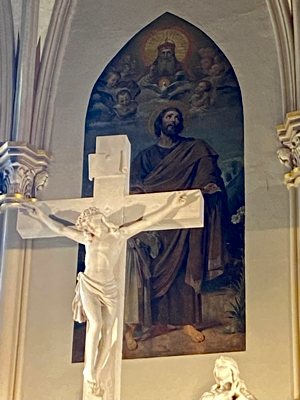The Mass is all about Jesus, the bridge between humanity and God. But on a recent Sunday morning at my new parish, I found my eyes drawn to someone else: St. Joseph.
To be fair, it wasn’t entirely my fault. The foster father of Jesus is prominently painted directly above and behind the altar, his eyes raised aloft to God, the Christ child at his side, and lilies growing in the background. If you’re looking toward the sanctuary, it’s hard not to have your eyes drawn up to St. Joseph.
But rather than a distraction from the Mass, I found that contemplating St. Joseph helped me enter the acts taking place on the altar in an even deeper way. And all because of one curious optical detail: at this Indiana parish, you can’t see the painting of St. Joseph in the apse without your line of vision first passing through the sculpture of Jesus being crucified atop the altar piece.
In other words, you can’t see Joseph except through Jesus Christ. And in another sense, you can’t look at Christ on the cross without seeing St. Joseph behind him.
Humor me for a bit, but there seems to be a spiritual lesson in this visual experience.
We often talk about how the saints lead us to Christ. They intercede on our behalf, and they model for us what loving God looks like. There’s no better example than the Blessed Mother, the mediatrix of all graces and the perfect disciple. As the popular spiritual dictum puts it, we go “to Jesus, through Mary.”
But it also works the other way. Jesus leads us to the saints. He points to them as “alters Christus,” living embodiments of his own self-sacrificial love. Love that was poured out 2,000 years ago on the cross for the salvation of all humanity, but is made manifest in different times, places and contexts through the lives of the saints.
Why is this relevant as we try to live lives animated by Christian charity today? Yes, Jesus is the Son of God, the Second Person of the Trinity, the Alpha and the Omega, the Incarnate Word, and the Lamb of God. And yet, during his earthly life and ministry, he never worked at a bank, lived out a calling as a biological parent, or used the internet.
But there are saints who have. And their lives, fueled by Christ’s love, can be compelling, concrete models of holiness for those of us who are called to similar vocations, circumstances or uses of our talents.
The image that comes to mind is a prism, which takes in light and manifests that light in diverse colors. Or perhaps a singular, powerful lens that illuminates things differently depending upon the object of its focus. When we look through this lens of Christ’s love, which saint do we see on the other side, illuminated as a model of holiness for our own lives?

For me, the ability to look through “the lens of Christ’s love” in my new parish — the crucifix atop the altar piece — and see St. Joseph, the patron of husbands, fathers and workers, is a powerful spiritual aid, allowing me to contemplate how I can be more Christ-like in my preparation for or practice of each of these callings.
My life of holiness — of incarnating Christ’s love according to my own particular vocation and circumstances — is going to look like St. Joseph’s in several ways. It will require me to die to self by putting the flourishing of my future wife and children above my own self-interest; to be diligent, humble, and steadfast in my work; and to be upright and open to God, so I’m prepared to lead in times of crisis.
And so, when I’m at Mass in my new parish, uniting my life to the offerings on the altar and preparing to receive Christ in the Eucharist to help me live a life of charity, I do so in the register of St. Joseph.
For others, perhaps looking through the lens of Christ will reveal someone like St. Elizabeth Ann Seton, an iconic teacher and educational advocate. Or St. Thomas More, a patron of lawyers and a portrait of courage. Or perhaps even a saint like Monica, the patroness of widows and mothers facing family difficulties.
You might not have a conveniently placed visual aid of your “model saint” like I do when I go to Mass at St. Joseph in Mishawaka, Indiana. But perhaps you can call to mind your own model of holiness through other means, like a prayer card you keep in your wallet or by asking for their intercession as you get in line to receive Communion.
Of course, no saint’s life will perfectly align with our own. Each of us is our own unique person, called to imitate Christ in an utterly irreplicable and non-derivative way. But areas of overlap shared with a saint can provide some concrete guidance on how to live out the Christian call to charity in our circumstances and ways of life.
After all, Christ doesn’t point us to the saints as ends in their own right. He shows us their witness, so they, in turn, can lead us to more fully and completely imitate him in all that we do.
Liedl lives in South Bend, Indiana, and is senior editor for the National Catholic Register. He is a former longtime resident of the Archdiocese of St. Paul and Minneapolis, alum of the University of St. Thomas’s Catholic Studies graduate program and current student at The St. Paul Seminary and School of Divinity, both in St. Paul.




